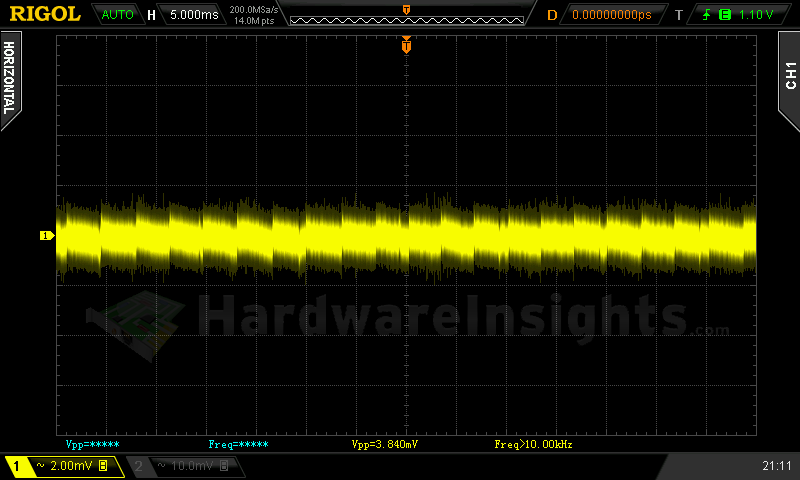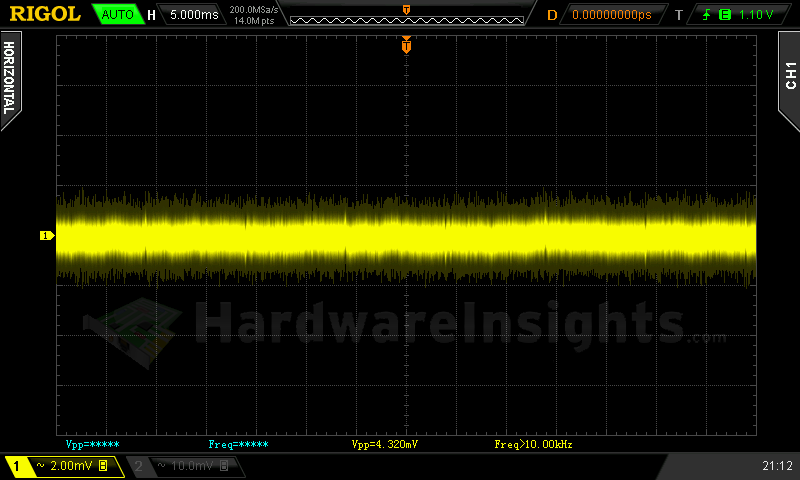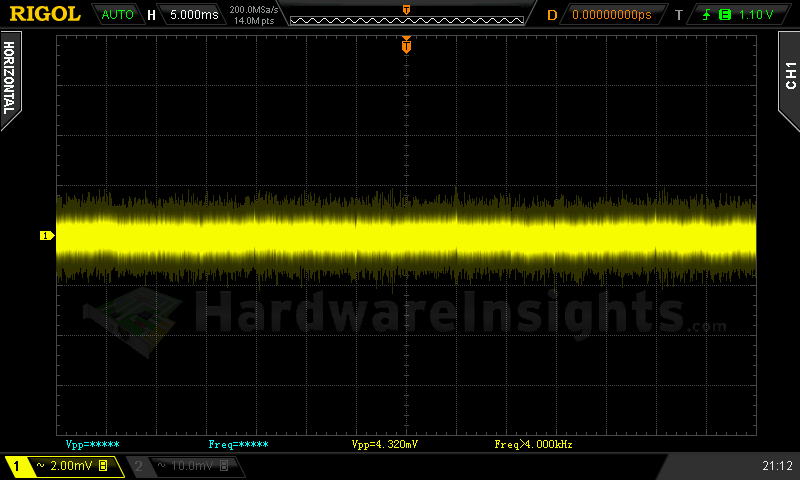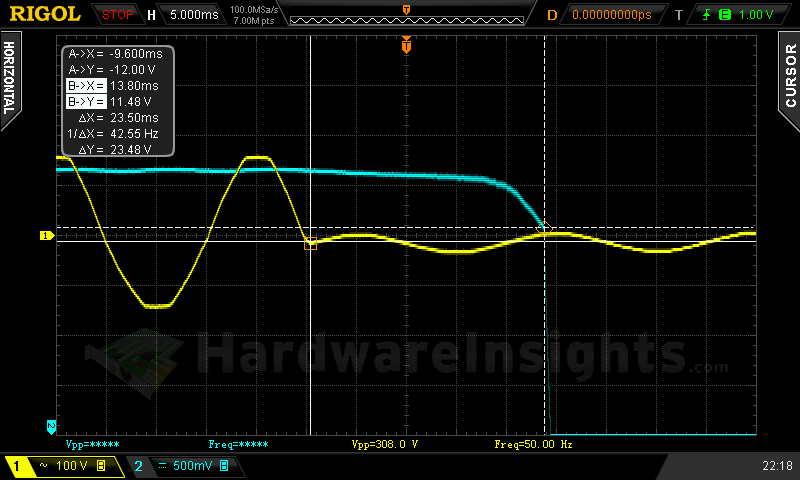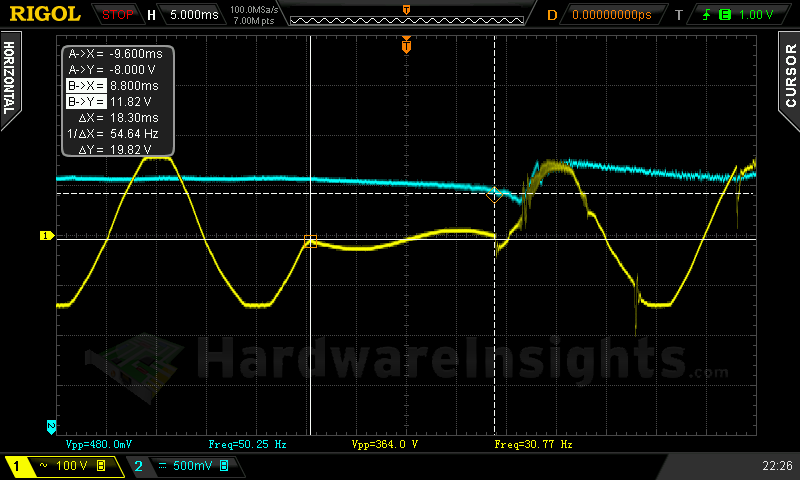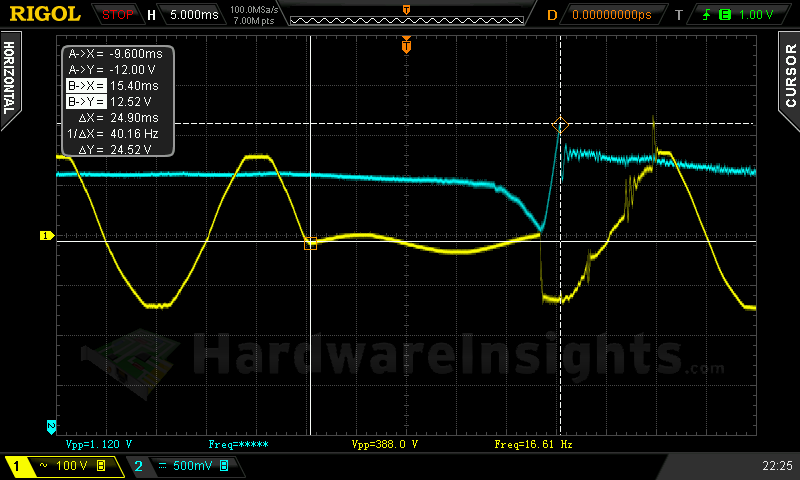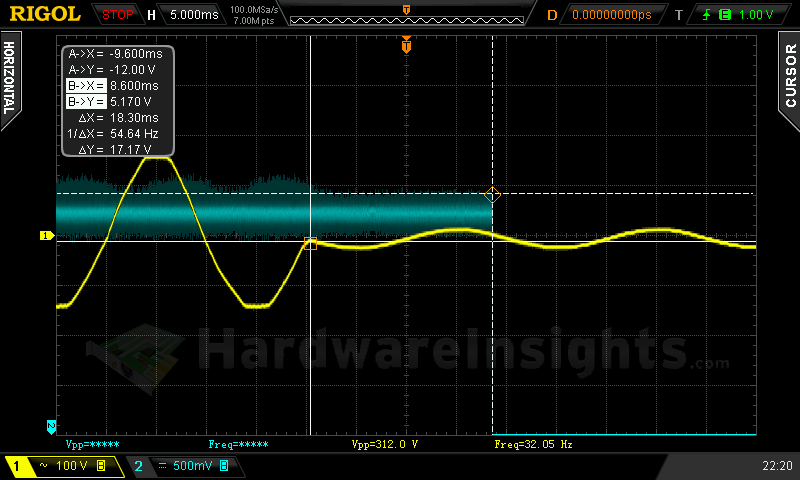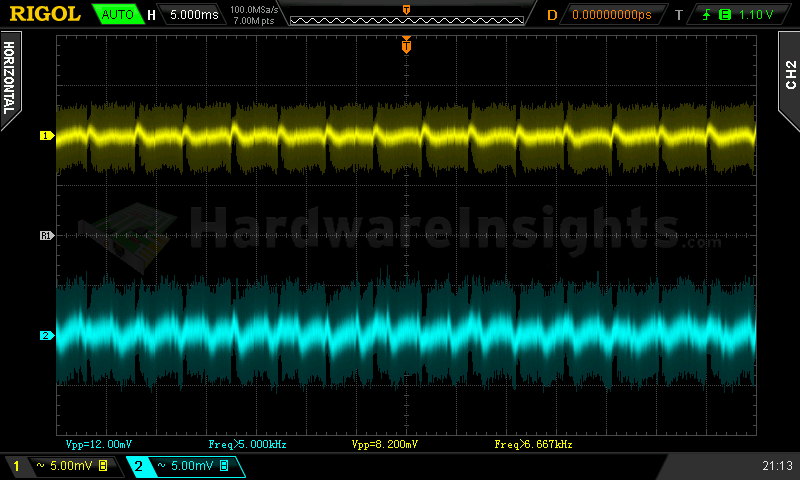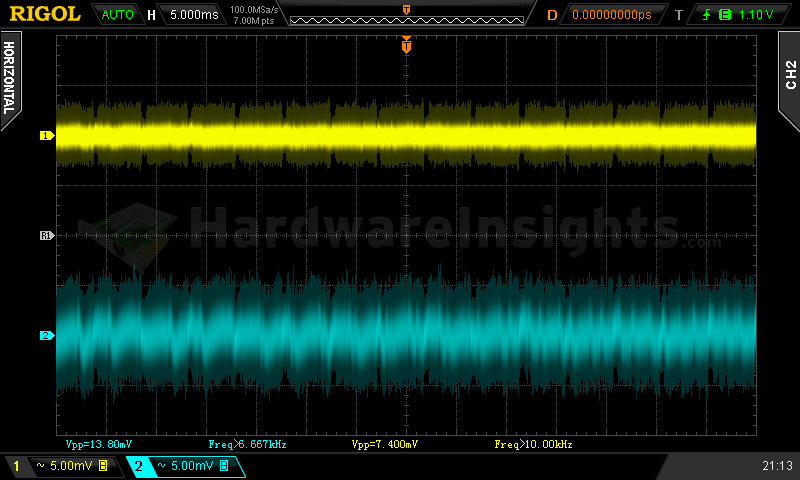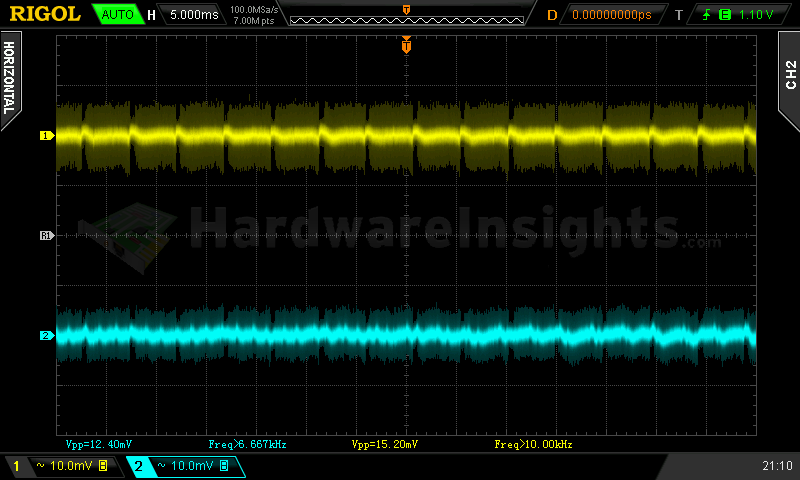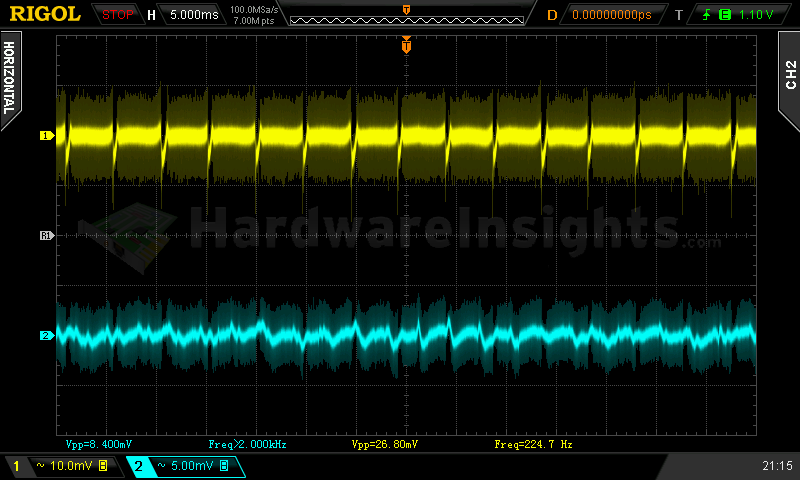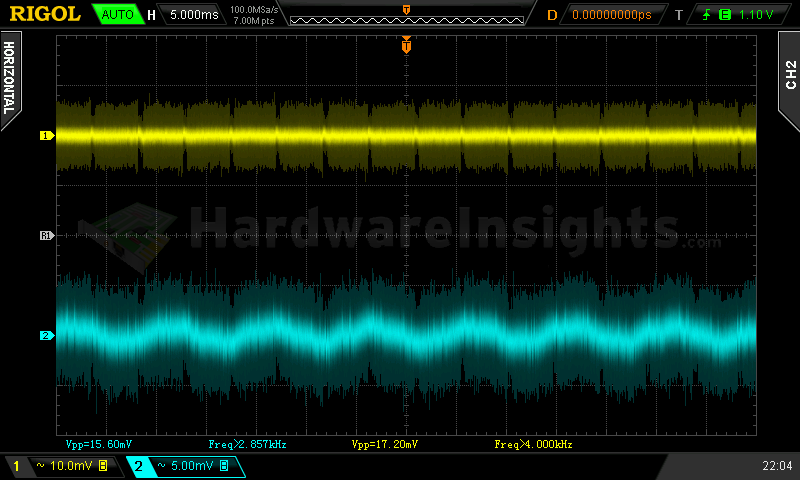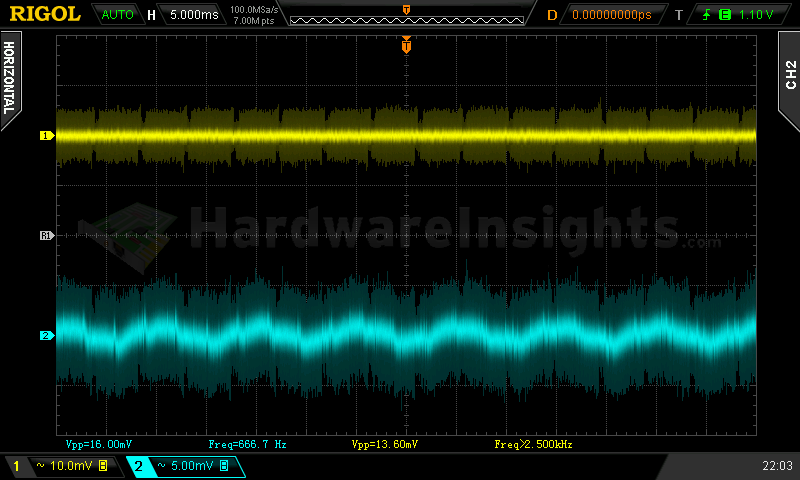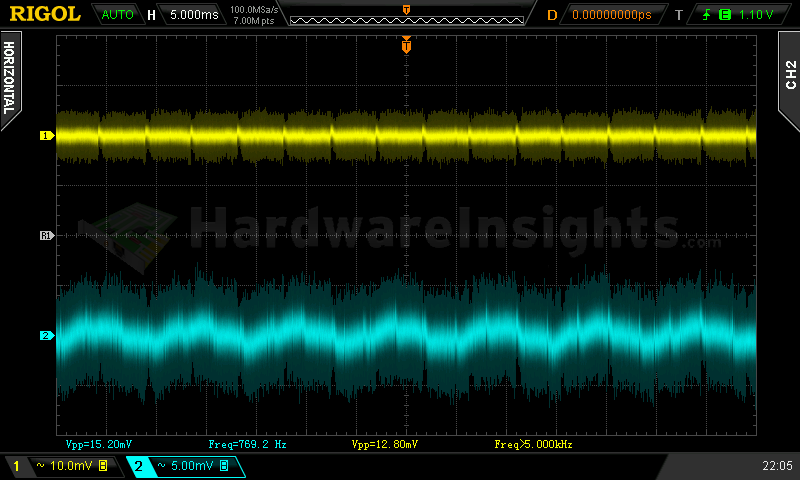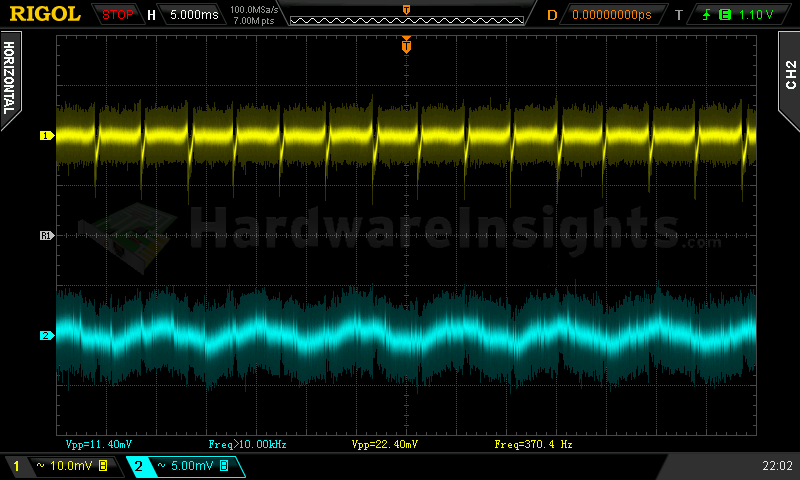Contents
- 1Introducing the Corsair HX750i
- 1.1Packaging and accessories
- 2Connectors & cabling
- 2.1Casing & cooling
- 3Input filtering
- 4Primary side
- 4.1+5 V stand-by rail
- 5Secondary side
- 5.1Build quality
- 6Load testing
- 6.1Loading +5 V SB
- 6.2Hold-up time
- 6.3Combined loading
- 6.4Combined loading ripple
- 6.5Crossloading, overloading
- 6.6Crossloading, overloading ripple
- 6.7Fan speed, temperatures and noise
- 7The Link
- 7.1The application
- 8Conclusion and evaluation
- 8.1Thanks
- 8.2Discussion
Load testing
Loading +5 V SB
As always, all load testing is done according to our testing methodology. You may notice the O-scope now shows one digit better accuracy. I have finally got enough of it when it ceased to save more complicated images even to USB storage so I upgraded the firmware. There was a looong list of bugfixes and it now works better than new. No surprise, I had still used the original factory release until now.
| Output (W) | Load (A) | Voltage (V)/ ripple (mV) | Input (W) | Efficiency/power factor |
| 0 | 0 | 5.06/3.840 | 0 | —/0.003 |
| 14.37 | 2.89 | 4.98/4.320 | 18.91 | 76.0 %/0.434 |
| 16.80 | 3.38 | 4.97/4.320 | 22.06 | 76.2 %/0.469 |
After a while, we see nice voltage regulation once again. The worst deviation from nominal was 1.2 %. Also the ripple is nice, under 5 mV. And also the efficiency is tiny bit better at 76 %.
+5 V SB ripple (left to right): 0 A; 2.89 A; 3.38 A
Hold-up time
As we can see on the oscilloscope screenshot, the hold-up time of the HX750i +12 V rail is quite long, 23.5 ms. This is nice.
When interrupting for such time, I found the unit can handle that OK. It can handle even slightly more before it starts turning off, but over 25 ms high voltage spikes appear.
I also checked the power-good signal hold-up time and it reached 18.3 ms, that is within ATX spec. As we can see, the voltage is well within spec at power loss for such time.
Combined loading
Combined loading was OK for the Corsair HX750i. Firstly, let’s talk about the voltage regulation. As this is a synchronously-rectified topology with DC-DC converters, the results are expected to be very good. Indeed, all the positive rails stayed within 2 % and the −12 V rail within 3 % (from 10 % alowed). We can see the result is slightly worse than of the RM550x as the HX750i lacks feedback wires for +5 and +12 V rails.
| Output power | Load/ voltage +5 V SB | Load/ voltage +3.3 V | Load/ voltage +5 V | Load/ voltage +12 V | Load/ voltage −12 V | Input power | Efficiency/ power factor |
| 3.9 %/ 29.04 W | 0 A/ 5.02 V | 0 A/ 3.30 V | 0.407/ 5.02 V | 1.819 A/ 12.16 V | 0.398 A/ −12.26 V | 40.07 W | 72.5 %/ 0.602 |
| 20 %/ 152.15 W | 0.518 A/ 5.00 V | 1.464 A/ 3.29 V | 1.152 A/ 5.01 V | 10.88 A/ 12.13 V | 0.395 A/ −12.28 V | 170.5 W | 89.2 %/ 0.942 |
| 40 %/ 303.75 W | 1.012 A/ 4.99 V | 2.80 A/ 3.28 V | 3.43 A/ 5.00 V | 22.1 A/ 12.10 V | 0.403 A/ −12.29 V | 334.6 W | 90.8 %/ 0.980 |
| 60 %/ 452.78 W | 1.88 A/ 5.00 V | 4.30 A/ 3.28 V | 4.93 A/ 5.04 V | 33.1 A/ 12.07 V | 0.402/ −12.30 V | 502.3 W | 90.1 %/ 0.992 |
|
80 %/ 601.04 |
2.36 A/ 4.98 V | 5.67 A/ 3.29 V | 6.06 A/ 5.02 V | 44.5 A/ 12.03 V | 0.399 A/ −12.30V | 666.8 W | 90.1 %/ 0.995 |
| 100 %/ 751.22 W | 2.82 A/ 4.97 V | 7.05 A/ 3.30 V | 7.9 A/ 5.02 V | 55.6 A/ 12.04 V | 0.397 A/ −12.31 V | 837.3 W | 89.7 %/ 0.996 |
We reached efficiency of almost 91 %. It is still slightly less than expected, though I have checked this time with an incandescent light bulb, and the power meter measures practically the same as my digital multimeter. Only the clamp meter showed lower number, though another (brand new) piece of the same model showed virtualy the same value. So my bet is that previous power meters showed slightly lower consumption while the clamp meter shows lower current. Now the power meter shows much more precise value but the clamp meter is still off. (Remember it has quite low accuracy of ±2 % +5.) As I do not know how much off, I will still work with this value.
Combined loading ripple
The ripple values of the HX750i are outstanding. Though the results are also slightly worse compared to the RMx, it is still very good. Definitely high-end unit, besides the −12 V rail, everything was within 20 mV.
| Output % | Ripple +5 V SB | Ripple +3.3 V | Ripple +5 V | Ripple +12 V | Ripple −12 V |
| 3.9 | 8.20 mV | 7.40 mV | 15.20 mV | 13.80 mV | 26.80 mV |
| 20 | 12.40 mV | 14.00 mV | 13.60 mV | 19.20 mV | 24.00 mV |
| 40 | 14.40 mV | 9.60 mV | 11.20 mV | 14.40 mV | 15.20 mV |
| 60 | 12.00 mV | 8.20 mV | 12.40 mV | 13.40 mV | 14.80 mV |
| 80 | 14.40 mV | 7.40 mV | 12.20 mV | 15.20 mV | 20.80 mV |
| 100 | 17.20 mV | 13.60 mV | 12.80 mV | 16.00 mV | 22.40 mV |
Ripple 3.9% load (left to right): +5 V SB; +3.3 V; +5 V; −12 V. The second channel is connected to +12 V.
Ripple 100% load (left to right): +5 V SB; +3.3 V; +5 V; −12 V. The second channel is connected to +12 V.
Crossloading, overloading
Crossloading tests went fine, as is expected from a platform utilizing DC-DC converters. The voltage regulation was mostly the same. Efficiency dropped further, even under 80 % with a crossload of the +3.3 V rail. I tried overloading different +12V rails and the unit mostly turned off between 40 and 42 A. That is just too much especially for the rail for Main ATX connector which only carries two +12V wires! But for those PCIe cables with three it is not entirely safe either. OCP with 40 A is just too much and may actually never even work. Because 40 A at 12 V needs just little over 0.3 Ω, so you may end in a situation when something fails and the unit will not prevent such component from burning/melting anyway. Yes, such situations are very rare, but they are exactly why the protections are there; with this setup, it kind of makes the protection useless in the end. It is also worth noting that while from Corsairs attitude in the specifications (label, manual, website) it is clear – at least to me – this is supposed to be a single-rail unit, the opposite is true: factory default is seven independent +12V rails, which may just be turned off through the Link software. I take one point down for this and one for that unsafe 40A OCP on Main ATX.
| Output power | Load/ voltage +5 V SB | Load/ voltage +3.3 V | Load/ voltage +5 V | Load/ voltage +12 V | Load/ voltage −12 V | Input power | Efficiency/ power factor |
| 15 %/ 110.04 W | 0.503 A/ 4.99 V | 23.6 A/ 3.32 V | 0.407 A/ 5.00 V | 1.834 A/ 12.15 V | 0.396 A/ −12.30 V | 140.1 W | 78.6 %/ 0.910 |
| 20 %/ 152.85 W | 0.557 A/ 5.20 V | 0 A/ 3.28 | 24.8 A/ 4.97 V | 1.824 A/ 12.14 V | 0.394 A/ −12.28 V | 187.0 W | 81.7 %/ 0.950 |
| 99 %/ 741.49 W | 0.502 A/ 4.98 V | 0 A/ 3.27 V | 0.417 A/ 5.00 V | 60.8 A/ 12.04 V | 0.396 A/ −12.30 V | 824.2 W | 90.0 %/ 0.996 |
| 117 %/ 877.29 W | 3.31 A/ 4.95 V | 2.96 A/ 3.26 V | 9.03 A/ 5.02 V | 66.7 A/ 12.01 V | 0.396 A/ −12.32 V | 987.2 W | 88.7 %/ 0.997 |
Checking OCP on any other rails (+3.3 or +5 V) was futile as I barely got enough power draw to load them up to the nominal output. The OTP works, but as the unit uses PWM controlled fan and it has a tachometer, you cannot stall it as it has protection for that. So I had to use the sweater and couple more layers to make it overheat. It finally turned off after more than half an hour with internal temperature of almost 70 °C. For this the unit will get 6 points as it actually has two extra and working protections. Combined overloading was OK, though the unit shut down quite fast at only 117 % of rated power.
Crossloading, overloading ripple
Here the ripple was similar to that of combined loading set of tests. The −12V rail was able to stay within 20 mV.
| Output % | Ripple +5 V SB | Ripple +3.3 V | Ripple +5 V | Ripple +12 V | Ripple −12 V |
| 15 | 11.60 mV | 7.60 mV | 12.40 mV | 16.40 mV | 14.80 mV |
| 20 | 8.40 mV | 12.00 mV | 6.00 mV | 17.60 mV | 15.60 mV |
| 99 | 6.60 mV | 8.00 mV | 8.00 mV | 13.60 mV | 20.0 mV |
| 117 | 8.40 mV | — | — | 16.00 mV | — |
Fan speed, temperatures and noise
The fan inside the Corsair HX750i started spinning not sooner than under test four (60% load, that is above 400 W). It is inaudible up to the fan speed of about 700 RPM, then it becomes audible yet tolerable, to approximately 1000 RPM. At 1150 RPM it was already making some noise. I recommend keeping it approximately up to 700 RPM for ultra silent configurations and up to 1000 RPM for silent configurations.
| Output % | Fan speed (RPM) | Temperature intake/ outtake | Noise (dBA) |
| 3.9 | 0 | 23 °C/ 22 °C | – |
| 20 | 0 | 26 °C/ 22 °C | – |
| 40 | 0 | 30 °C/ 23 °C | – |
| 60 | 566 | 23 °C/ 34 °C | 38.7 |
| 80 | 780 | 24 °C/ 37 °C | 38.9 |
| 100 | 1041 | 25 °C/ 37 °C | 39.0 |
| CL 15 | 1020 | 22 °C/ 29 °C | 39.0 |
| CL 20 | 1093 | 21 °C/ 27 °C | 39.2 |
| CL 99 | 920 | 24 °C/ 32 °C | 38.9 |
| OL 117 | 1155 | 26 °C/ 46 °C | 39.5 |
The temperatures were quite OK, maximum output was not even 50 °C under overload test. The figures are now finally more accurate in terms of absolute values as I did some home calibration of the thermometer. The HX750i unit is specified as able to work with 50 °C ambient so no problem here anyway.
